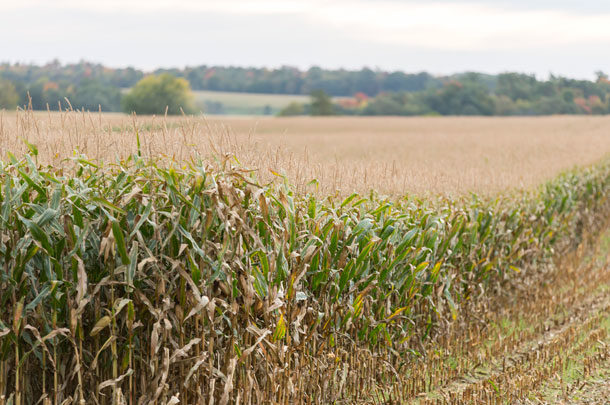When planting to achieve higher populations, growers must deal with soil, water, insects, diseases, climate and genetics – and they must consider goals for total volume, digestibility, protein, starch and moisture content. Higher populations and narrow rows may impact each of these factors. Identifying and resolving these challenges can help growers make decisions that best suit their needs.
Row spacing and corn silage yields
Growers are constantly evaluating how evenly they are planting corn, and how their equipment and techniques are working in the field. Uniform plant spacing helps maximize yield by reducing uneven emergence, non-uniform leaf spacing and varying plant heights. Using these best practices can help eliminate skips and double plantings as well.
At higher populations, narrow rows reduce the crowding of plants within a row, reducing competition between individual plants and potentially enhancing their use of available light, water and nutrients. Corn grown in narrower rows, however, can increase internode elongation and ultimately plant heights. Taller plants can cause higher incidence of lodging and green snap, and slightly slower plant maturation; this can result in decreased percentages of starch content, dry matter at harvest and fiber digestibility. To address these issues, growers can adjust their hybrid selection and harvesting schedules.
Higher yield rate potential based on narrow-row spacing also varies geographically, which creates unique challenges for growers considering implementing these practices. Thirty-seven experiments conducted in Wisconsin, Michigan, Pennsylvania and New York compared yield differences between 15-, 20- and 22-inch row spacing against 30-inch row spacing. While the average tonnage increase was 7 percent, Michigan had the highest increase at 8.4 percent using both 15- and 22-inch row spacing, and New York had the lowest at 4.2 percent using 15-inch row spacing. This means each grower needs to take into account geographic considerations as they assess the appropriateness of narrow-row spacing for their fields.
Increased populations and corn silage yields
Plant populations for ideal corn grain yield in the central Corn Belt typically range from 32,000 to 36,000 plants per acre and run higher in the northern Corn Belt. Growers are advised to consider increasing the target plant population of corn silage by 10 to 20 percent per acre compared to corn harvested for grain. Researchers have reported consistent increases in dry-matter yields with increased populations.
However, research indicates that increased populations can produce lower quality silage yields due to increased fiber content of the silage. In private product trials conducted in LaSalle, Colorado, from 2004 to 2007, whole-plant digestibility (WPDig) decreased by 1.4 percent when plant populations increased from 18,000 plants to 42,000 plants per acre. The trial reviewed combinations of 28 hybrids in 30-inch row spacing with 18,000, 24,000, 30,000, 36,000 and 42,000 plants per acre.
Anticipate and address issues to prevent complications
Growers should consider making adjustments based on increased populations and decreased row spacing plus the effects on silage yield quality when switching to narrower rows. Proper planning is necessary to address the following:
-
Equipment compatibility and staffing
- Changes can require equipment purchases or custom operators for planting and harvesting. Growers are often committed to harvesting narrow-row corn for silage due to available equipment and staff at specific times, and they schedule harvesting as early as possible to ensure that resources are available at optimal maturity.
-
Soil fertility
- Adjusting planting practices will affect the volume and pace of nitrogen use. Growers should make necessary modifications to soil-testing plans to monitor the impact of narrow-row spacing as practices are implemented.
-
In-season application
- One possible solution that some narrow-row operators employ is the use of tramlines to provide mid-season access, as narrow rows inhibit some in-season fertilizer applications. Growers will need to evaluate post-harvest applications or split applications to allow room for equipment and to ensure that fertilizer applications are effective. In other words, ensure that the fertilizer is available to growing plants at the right rates at the right times. In areas where foliar disease is yield limiting, narrow rows may demand that some rows be sacrificed for ground application or require aerial applications to remediate the pathogen pressure.
-
Water demands
- Plant population changes require an in-depth evaluation of irrigation and hybrid selection to ensure proper utilization of water resources.
-
Post-emergence weed control
- Pesticide and herbicide schedules may need adjustments to accommodate changing planting practices.
Consult with professionals
Growers must decide whether the benefits of increasing populations and decreasing row spacing justify the work involved in addressing these planting practice changes. Working through these issues with a local expert or authorized sales representative can help growers identify, address and prevent long-term complications. FG

Daniel Mongeau
Field Agronomist
DuPont Pioneer
PHOTO
Photo provided by Daniel Mongeau.











